Clean results and maximum economy:
processing of compost screen overflow
Without preparation, compost sieve overflow must be disposed of thermally at high cost. By carefully separating and processing the screen overflow, costs can be reduced and several useful fractions can be obtained.
The solution offers the right technology for each individual process step, which reliably sifts, separates and cleans – whether as a customized complete system or as a useful addition to existing components

The process for treating compost sieve overflow consists of a wind sifter, a swim-sink separation with washing the light goods and a process water treatment. This is how several useful fractions can be generated:
- High calorific substitute fuels (foils)
- Regenerative medium-calorie substitute fuels Compost structure materials (biomass)
- Inert stone fractions
All product fractions are reliably and thoroughly freed from sand and compost buildup.

Process description for preparation
The process for the treatment of compost sieve overflow consists of an air classifier, a swim-sink separation with a washing of the light goods and a process water treatment. The screening machine screens the fine compost.
The screen overflow goes directly into the air classifier, where the light film is separated. The films can be added to the combustion as a high calorific fraction.
The heavy fraction continues in the sinking separation to separate stones from wood. The floating fraction goes back to composting as a structural material.
The rest can be used in a biomass power plant. The water is cleaned of suspended matter and sediments by a lamella separator and circulated as process water.
The water treatment normally consists of a lamb separator and a dosing station. In this way, the space requirement of the entire system can be kept low.
In contrast to a conventional sedimentation tank, it is also possible to offer demonstrations and services.
Compost sieve overflow must be disposed of thermally without expensive treatment. Processing can reduce these costs.
The process at a glance

Advantages
- Lower disposal costs
- Less space required for the entire system
- Recycling the compost structure
- Sale of clean biomass fuel


